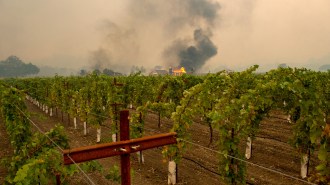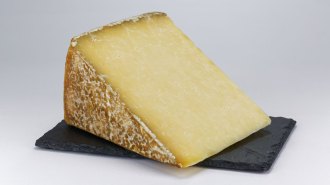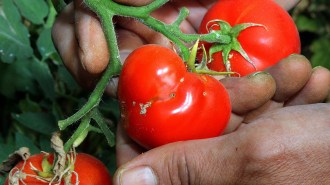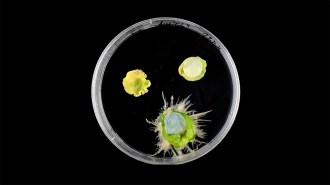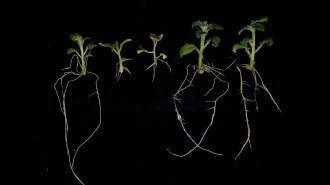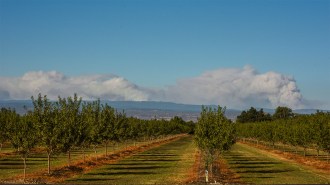Cleaning Up after Livestock
As any pet owner knows, the more food that goes into an animal’s mouth, the more wastes that eventually spew out the other end. The bigger the animal, the bigger its appetite. So imagine the volumes of manure—often tainted with germs—that farmers must manage for even a small feedlot with perhaps 3,500 head of cattle.
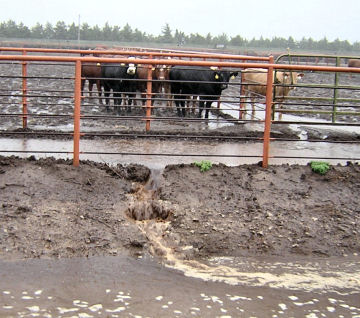
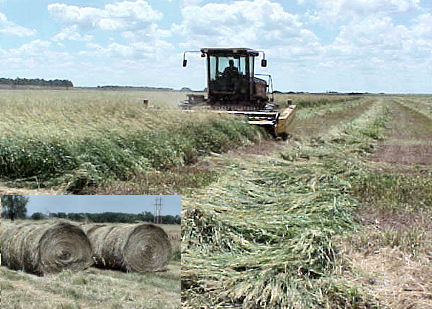
Ordinarily, beef producers house their animals in pens—some the size of football fields or larger. They’re designed to leave each animal about 80 square feet of space. Cattle wastes just fall to the ground and collect—often for a month or more—before feedlot crews periodically scrape away the muck. After composting, the dried manure will be applied to fields as a rich fertilizer.
The real problem develops when it rains. Then, a manure-rich, watery slurry can drain off the fields. Conventionally, feedlot managers would divert this liquid into huge, smelly ponds or lagoons—some 10-feet deep or more, explains Bryan L. Woodbury, an agricultural engineer with the U.S. Department of Agriculture’s Meat Animal Research Center in Clay Nebraska.
His team has been developing a literally greener alternative to pond storage for manure-laced runoff from feedlot pens. The new system directs that runoff into a foot-deep drainage basin. Leading out of it are a series of narrow pipes. Because the interior diameters of these pipes are small, rain-deposited wastes temporarily back-up in this glorified drainage ditch. It typically takes hours for all of the liquids to fully drain out through the pipes. While they wait, solids in the rain-manure slurry tend to settle out as sediments that will accumulate on the basin’s bottom.
Exiting liquids, meanwhile, flow gently into a mildly sloping field of grass, where the animal wastes will fertilize the plants’ growth. At the end of the season, farmers harvest that grass as hay, bale it, and then feed it back to the herd.
For much of the past decade, Woodbury’s team has tinkered with the system’s design to optimize gravity’s removal of solids from the initial rain-manure slurry and the pace at which fertilizing water enters the hayfield. In terms of those features, the system appears ready for prime time—at least in the Midwest, Woodbury says.
However, what hadn’t been evaluated was the fate of germs that were shed by cattle along with those wastes. If the brief holding of the manure-water slurry and its subsequent release into fields promoted the growth of disease-causing microorganisms, those germs might eventually find their way into plants (see Not Just Hitchhikers). That would risk re-exposing animals that later dined on the tainted hay.
A new investigation now indicates that although the raw manure often hosts germs, most of the nasty microbes hitchhiking in it appear to settle out along with sediments in the initial holding basin. Bugs that remain suspended in the water long enough to travel on to the fields don’t appear to survive there long, Woodbury and his colleagues report in the Nov. 1 Journal of Environmental Quality.
Indeed, the researchers note, while their new data “indicate that there is some risk for hay contamination, it appears to be low.” For instance, on one day that hay was cut—two weeks after a major rainfall that shunted diluted manure into the field—only four of 10 tested soil samples hosted Escherichia coli O157.
Yet only one of the 30 samples of loose hay that was cut that day from parts of the field that had received manure-fertilized rainwater tested positive for that E. coli strain. Microbiologists also failed to later detect that E. coli O157 in hay following its baling and storage.
That’s encouraging news because this bacterium has a long track record of causing disease. It was, for instance, responsible for the major food poisonings associated with tainted spinach in September 2006—an outbreak that sickened more than 200 people, killing five. These microbes can set up housekeeping in the bovine gut, causing no harm to the animal. However, germs shed in the cow’s feces can infect people or crops that contact it.
The Nebraska researchers also probed for evidence of Campylobacter, another bacterium shed by cattle that can provoke gut-wrenching illness. And although three of 10 field-soil samples tested positive after one major rain, none did 2 weeks later. The germ also failed to show up in loose or baled hay.
Similarly, even though the test herd of 750 cattle had been periodically shedding large quantities of Cryptosporidium and Giardia—two common parasites responsible for substantial human disease, especially in persons with weakened immune systems—biologists found none of these microbes in field soil, much less the hay that had been grown on it.
Woodbury and his colleagues conclude that their vegetative filtering of manure washed off of feedlots is effective in dramatically sequestering and ultimately removing several of the major families of microbes responsible for human, food-related illness.
What they don’t yet know is whether there will be significant rainfall constraints to their system’s efficacy. Will arid regions benefit from it? Will very wet areas send so much fertilizer to hayfields that they burn the grass? “That’s what we’re in the process of testing right now,” Woodbury says. “The jury’s still out.”
Other advantages
Earlier tests showed that the short-term basin storage of wastes upstream of the hayfield removes about half of the nitrogen in manure and almost all of the phosphorus, Woodbury says. That’s important because one of the primary problems associated with fertilization of farm fields has been their release during rains of any unused nitrogen and fertilizer into streams.
Eventually, the fertilizing effects of these nutrients in surface waters can fuel the growth of algae that ultimately suck most of the oxygen out of large patches of coastal waters, creating what are colloquially termed dead zones (see Limiting Dead Zones).
The new waste-sanitizing system’s basin also removes most of the solid material suspended in the rain-manure slurry. This means that about once a year, people must excavate the buildup from the basin. However, what they remove is no longer a waste, but yet another fertilizing amendment for farm fields.
Oh, and Woodbury points to another potential advantage of his team’s new system—something that he refers to as the “white picket fence effect.” When people see a picket fence out front, they focus on that pleasant feature, and not every detrimental facet of a house or yard. Well, nobody views a big, smelly lagoon filled with bovine fecal material as the farm equivalent of a white picket fence, he says. A hayfield, on the other hand: That’s almost Norman Rockwell Americana.
If you would like to comment on this Food for Thought, please see the blog version.
